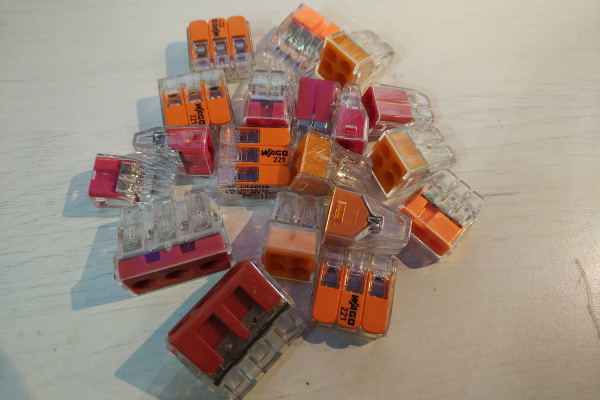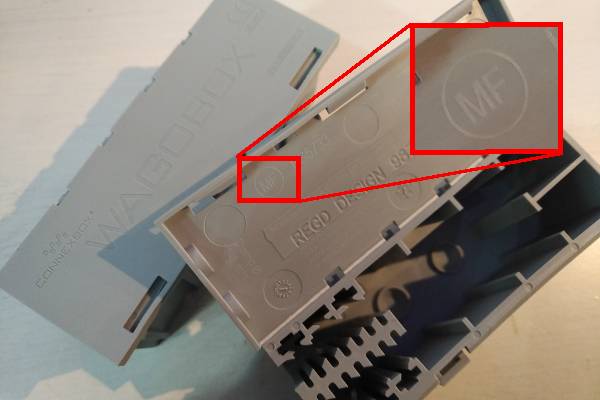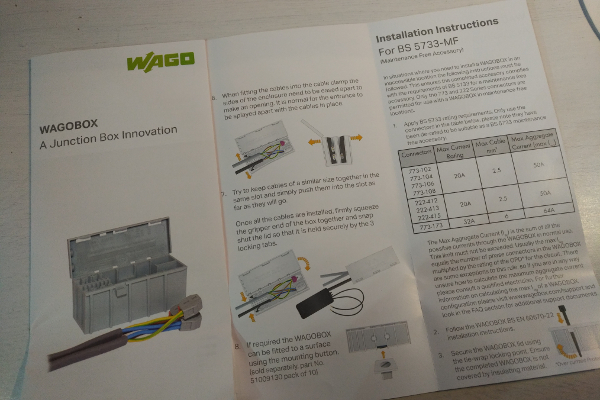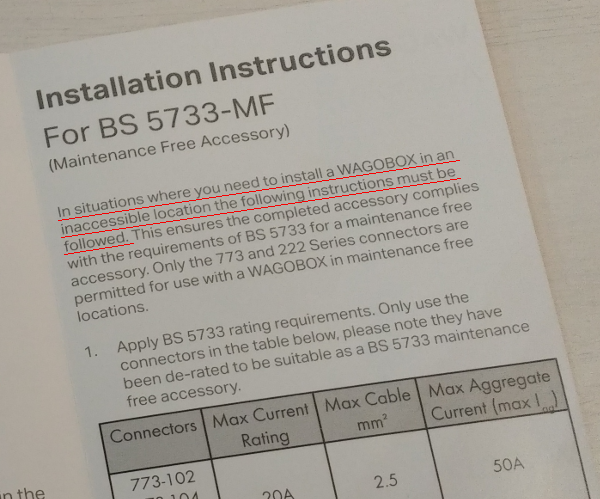Do the wiring regulations allow you to install an electrical junction where it cannot be accessed again afterwards? The short answer is Yes, but conditions apply...
When designing the wiring layout for a new circuit, best practice would be to avoid placing any electrical junctions in locations that are not easily accessible for future maintenance and inspection; Regulation 513.1 stipulates such. When modifying an existing circuit however, there will inevitably be some instances where an electrical junction needs to be retrofitted to accommodate change, but that may necessitate mounting it where that junction will not be readily accessible afterwards.
A maintenance-free junction connector provides the means of joining wires together in such a way as to hold them permanently in position without the possibility of unwanted disconnection. A traditional screw terminal is not an example of a maintenance-free connector as the screw can work loose over time leading to a failed connection or high resistance joint. In the case of the former, the circuit may stop functioning altogether, while the latter could see a build-up of heat potentially leading to fire, that is unless you perhaps have a new-fangled AFDD installed!
An illustration of a retrofit requirement would be where a homeowner wants a new socket outlet installed in their bedroom as part of a makeover. They’re quite happy for you to pull up the floorboards and chase the walls as it’s all going to be made good afterwards, so to tap into the existing wiring under the floor to serve a new socket spur you have no choice but to splice in a junction. If the homeowner is planning on laying a new carpet or laminate floor over the floorboards afterwards, then this junction would be considered by most as being inaccessible as a return to it necessitates the removal and possible damage to final finishes. This is where the likes of a screw junction must not be used, however there are alternatives. Traditionally crimp and solder joints, when made correctly, have been considered as semi-permanent connections with a low risk of failure, and today there are modern push-fit and clamp connectors which are quick and convenient for the installer, require no special tools unlike their crimping/soldering counterparts, and are also considered to be semi-permanent so long as they comply with BS 5733.
One popular brand of such connectors is made by the German company Wago, my personal choice for this type of product, although Ideal and HellermanTyton are examples of other reliable brands with product portfolios that prove just as capable.

Some push-fit and clamp junctions made by Wago and Ideal
I posted a YouTube video last year (below) about the failure of one particular maintenance-free junction connector which had been stocked by my local branch of CEF and was unrelated to the above companies, although the physical resemblance to Wago’s line was almost identical. That product failed a couple of weeks after installation, and I thank goodness it had been installed in an accessible location so that I wasn’t having to pull up a customer’s floor under warranty and at my expense to fix the problem!
By saying that, I opened myself up to some armchair experts who commented that junctions should never be installed in a location that was inaccessible. Obviously in practical terms such as the scenario I described earlier, an installer may have no choice but to locate an electrical junction where return access for alteration or inspection may be difficult in the future. So, who is right? Well, let’s assemble the facts and put this to bed...
We'll start with the troublesome word 'accessible'. Troublesome because the word ‘accessible’ isn’t defined in BS7671, the British Standard for the wiring regulations. How inconvenient it may be to get to an electrical connection before it is no longer considered to be truly accessible is really a decision for the installer. Personally, I view the removal or breaking into of final finishes to gain access to any connection to be too much trouble to be considered as accessible, but another installer may argue that taking up a client’s laminate floor or carpet is perfectly okay so long as they are willing to make good again afterwards. BS 7671 doesn’t come down on either side and it is deliberately open to interpretation to allow any given installer the freedom to use their own judgement and common sense for the situation they find themselves in.
When I make any public comment about the electrical installation industry, I do so purely for the UK market. I have no experience of, or qualifications for, foreign electrical regulations, although the British Standard for the wiring regulations is closely aligned to the rest of Europe.... yet any British sparkies who have travelled abroad on their holibobs may well have raised an eyebrow or three at some of the shenanigans on display in some of the beach bars!
There may well be another country with different wiring regulations that explicitly state all electrical junctions must remain accessible, as well as defining specifically what ‘accessible’ means, but that is not the case here in the UK. Someone making an anonymous YouTube comment arguing for accessibility as a definitive requirement should be able to back up their blag by quoting the specific regulation and by stating which territories it applies to, otherwise they’re just airing an opinion, and that counts for nothing when weighed against the facts.
Speaking of facts, let me back this whole thing up by quoting from Regulation 526.3 as listed in BS7671 Amendment 3 (2015) which is in force in the UK at the time of writing:
“Every connection shall be accessible for inspection, testing and maintenance, except for the following...”
This regulation then goes on to list the six exceptions when it is acceptable for connections to be made where they may be considered inaccessible, examples being a joint designed to be buried in the ground (e.g. an armoured cable splice), and where joints are made in a semi-permanent way such as by soldering and crimping. I’m not going to list what all six exceptions are because a bona fide UK electrician can look it up for themselves. If someone is making anonymous YouTube comments without access to the regs book, then I doubt them to be a valid and qualified electrician and I don’t consider them to be one of my peers; they’re just airing an ignorant opinion, and again, that counts for nothing when weighed against the facts.
I will list here the sixth exception as listed by Regulation 526.3 which allows “equipment complying with BS 5733 for a maintenance-free accessory, marked with the MF symbol and installed in accordance with the manufacturers' instructions” to be exempt from having to be accessible. Wago push-fit/clamp products, and those of other similar reputable manufacturers are configurable to BS 5733, and the Connexbox enclosure which accompanies these products is an example of an enclosure which does indeed carry the MF symbol...

The instructions provided in a 10-pack of Connexbox accessories explains how to make the product compliant with BS 5733-MF “..in situations where you need to install a Wagobox in an inaccessible location...”.


To comply with the requirements, the connectors need to be de-rated, i.e. the 773 series normally rated at up to 24A can only be used with a maximum design current of 20A, and the enclosure itself should not have an aggregate current of more than 50A (64A if using the 773-173 connectors). The enclosure must also be sealed with a cable-tie so that it remains closed and can only be opened with the use of a tool. These are black-and-white manufacturers instructions, so anyone making YouTube comments bleating on about push-fit or clamp connectors not being suitable for inaccessible locations is airing an opinion publicly claiming these commercial products to be substandard and not meeting their manufacturer’s claims. If enough people are daft enough to listen, then good luck to them when Wago’s lawyers get in touch, because Wago’s testing to a British Standard will stand for more in court than any single idiot's ill-informed opinion.
To any armchair experts who still believe all electrical junctions *must* remain accessible, then I’ll say it’s fine, you don’t have to abide by Regulation 526.3. In fact, you don’t have to abide by BS7671 at all as the wiring regulations in the UK are non-statutory which makes them guidance rather than law. If you want to rewire a house using non-standard wiring colours, undersized cabling, accessories that fail to meet British or European standards and leave exposed live copper hanging out of the walls, then you are quite at liberty to do so. Two things though...
- If it was your own home you can be prosecuted for failing to comply with Part-P of the Building Regulations which is statutory, and you can be required to fork out costs to make good. If your electrical tampering causes death, injury or serious incident such as a fire then you will be prosecuted for your ineptitude, the sentence of fine or imprisonment reflecting the damage you’ve caused. If you’ve burned yourself out of your home through your own incompetence, your home insurance will not be worth the charred remains of the paper it was once written on, so all the best with sleeping in your car.
- If you ignored the guidance of the wiring regulations as a contractor to the detriment of life or property, you can be prosecuted under the Electricity at Work Regulations (EAWR) (1989) by the Health and Safety Executive with a fine or imprisonment on the menu depending on how much of a dunce you have proven yourself to be as these guys found out with the death of a child on their hands.
Although non-statutory, the best way to stay out of court, or to argue your defence if you do wind up in the dock, is to demonstrate compliance with the wiring regulations and any relevant installation instructions.
To summarise....
Under BS7671, the UK wiring regulations, Regulation 513.1 requires that all electrical connections are accessible except where it meets one of the six criteria specified by Regulation 526.3. Regulations in other countries may differ. BS7671 does not define what ‘accessible’ means and it is open to interpretation.
Wago (and other reputable connector manufacturers) make both push-fit and clamp connectors which can be installed to the requirements of BS 5733 and can be used in those locations which may be considered as being inaccessible due to the effort and/or expense that would be required in re-gaining access to those connections later. To comply with BS 5733, the connectors must be de-rated and installed in an enclosure sporting the MF logo, then sealed so that it cannot be reopened without the use of a tool. Any other stipulations listed in the manufacturer’s instructions must also be followed.
BS7671 and manufacturer’s instructions are non-statutory guidance in the UK, but failing to follow either may cause you to fall foul of the legal system as you will be required to prove you weren’t responsible for any incidents or accidents which later occur following any electrical tampering by your own hand. In short, you’re guilty unless you can prove yourself innocent should that circuit you fiddled with later catch fire or kill someone.
All of the above are verifiable facts, and while I am by no means the most knowledgeable electrician either in this grey and windswept kingdom or indeed the wider world, I’m stating these facts as someone who does have the qualifications and experience in the relevant field. This is my living; I run a business doing this stuff day to day. I’m a level 3 qualified electrical inspector which is perhaps more than most jobbing sparkies you’ll find for hire. I’m the Qualified Supervisor for my company which means I am assessed by the accrediting bodies of NICEIC under their Approved Contractor scheme and also by the ECA. If you’re an anonymous YouTuber who thinks I don’t know what I’m talking about then that’s okay, but when you volunteer an alternative point of view, do provide your own evidence to back up your position, otherwise you just make yourself look like one of those ignorant teenagers doling out troll comments during pizza/masturbation breaks while playing Call of Duty for twenty hours a day in your parents' basement.


